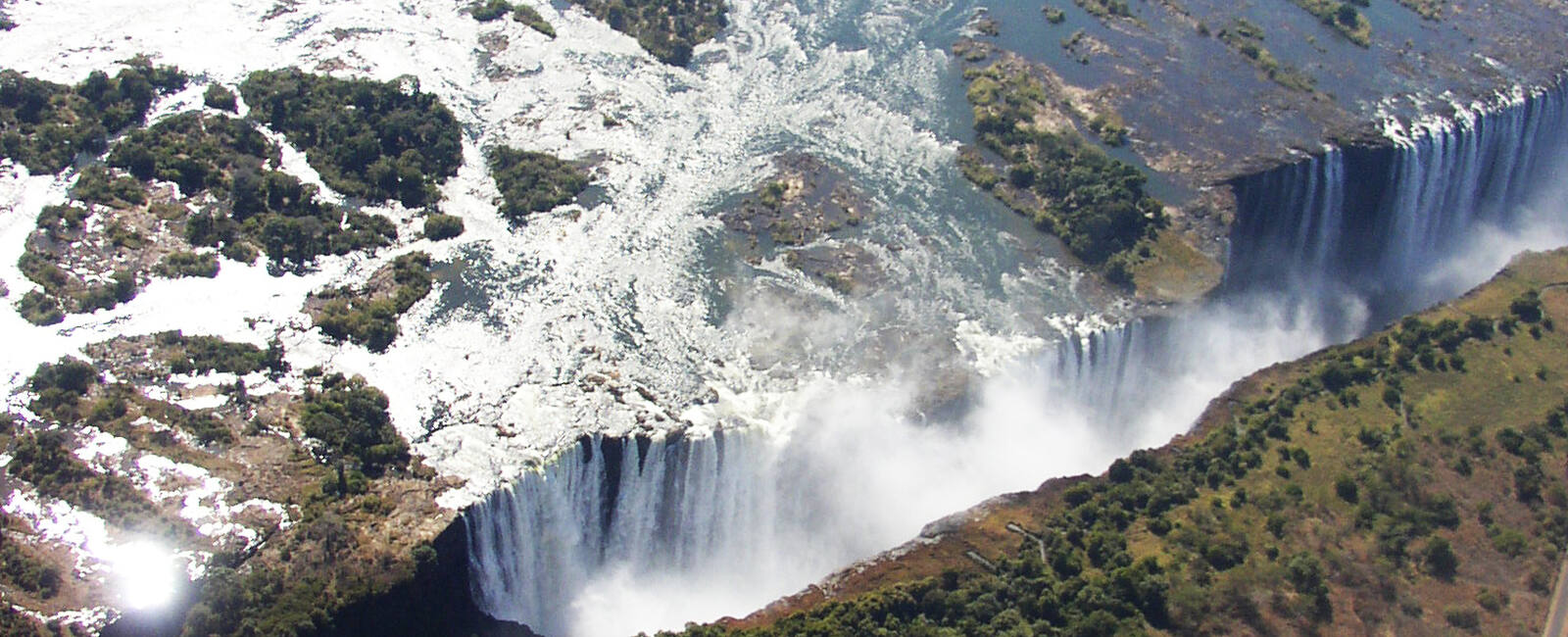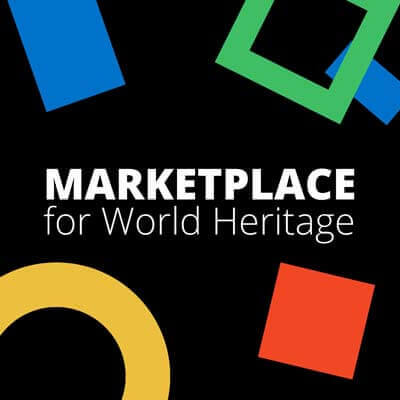Improving the Effectiveness of the World Heritage Reactive Monitoring Process
The Reactive Monitoring process established under the World Heritage Convention is one of the most comprehensive systems of monitoring ever developed under an international legal instrument in conservation. However, some of the key stakeholders involved in its implementation do not always fully understand this process and its multifaceted associated procedures.
The objective of the following project is to strengthen the implementation of the World Heritage Convention by improving the effectiveness and the understanding of its Reactive Monitoring process, including the benefits of the inscription of properties on the List of World Heritage in Danger.
Funded project
US$ 100,000
Duration
1.5 year
Beneficiary
Global
Category
Conservation
Document
Download project description

Context
By being Parties to the 1972 World Heritage Convention, 193 countries have already recognized that the sites located on their national territory, and which are inscribed on the World Heritage List, constitute a world heritage “for whose protection it is the duty of the international community as a whole to cooperate”.
Reactive Monitoring is defined as being the reporting to the World Heritage Committee on the state of conservation of specific sites inscribed on the World Heritage List and which are under threat. To this end, reports are prepared by the UNESCO World Heritage Centre and the Advisory Bodies (ICOMOS and IUCN). States Parties can also ensure the accuracy of those reports, inter alia by submitting their own reports within the statutory deadlines, early information on any development or restoration project, by providing sufficient and relevant information during missions, etc.
Since 1979, over 3.300 reports on the state of conservation of 536 World Heritage properties have been examined by the World Heritage Committee. On average, 150 properties are monitored yearly through the Reactive Monitoring process, including those inscribed on the List of World Heritage in Danger.

Outcomes
& Beneficiaries
- Clear guidelines on the purpose of the Reactive Monitoring process and its organization will be proposed, accompanied by a set of recommendations addressed to the various stakeholders of the Convention to further streamline the process and the procedures, and improve both their effectiveness and wide understanding.
- The evaluation will also provide a better understanding of benefits of the inscription of properties on the List of World Heritage in Danger.
Appropriate information material will be developed both to better communicate on the Reactive Monitoring process and its procedures with all key actors, especially decision-makers, national focal points, site-managers, local communities and the civil society, and to overcome the current negative perceptions of the List of World Heritage in Danger.

Objectives
- Strengthening the implementation of the World Heritage Convention by improving the effectiveness and the understanding of its Reactive Monitoring process. The current lack of understanding hampers the proper implementation of the decisions adopted by the World Heritage Committee at site-level and have a negative impact on the state of conservation of the properties these decisions are deemed to protect.
- Demonstrating the benefits of the inscription of natural and cultural properties on the List of World Heritage in Danger to overcome the negative perceptions of this List, highlighting the importance of the protection of the Outstanding Universal Value, which justified their World Heritage status.
In addition, a selection of relevant case studies shall complement the activity to illustrate the various issues identified, in terms of success stories, good practices but also in terms of difficulties.

Relevance
During its 40th session (Istanbul/UNESCO, 2016), the World Heritage Committee highlighted that the Reactive Monitoring process is a key indicator of the effectiveness of the Convention itself and that it provided a unique global overview of the state of conservation of natural and cultural heritage. It was however stressed that its content and its procedures were not always clear for all key actors and that there was now a need for an evaluation of the effectiveness of this process.
Committee members highlighted that the List of World Heritage in Danger was often perceived by many actors as a “degrading list” and decided that it was high time to reverse this negative perception and to highlight the benefits of such ‘in-Danger’ listing (Decision 40 COM 7).
The World Heritage Centre being the Secretariat of the World Heritage Convention, it is the best positioned to undertake such evaluation of one of the most crucial processes of this Convention.

Timeline
The following timeline for the evaluation of the effectiveness of the Reactive Monitoring process can be envisaged.
- Month 1 to month 10: Data gathering and interviews with key actors, as needed - Report writing
- Month 11 to month 14: Preparation of the appropriate information material and documents
- Month 15/16: Presentation of the report and side-event to launch the information material
It is to be noted that ideally, the presentation of the report at the end of the process should intervene during a session of the World Heritage Committee (which takes place each year in June/July).

Budget
An estimated overall funding of US$ 100,000 is needed for the implementation of this activity.
These funds will cover consultants fees (for both natural heritage and cultural heritage), travel and accommodation expenses, communications, joint report production, as well as translation in the two official languages of the Convention, design and printing of the appropriate information material.

Visibility
A communication & visibility plan will be developed in consultation with the donor(s) and will include (but not limited to) the options below:
|
Visibility material |
Placement / Event |
Outreach |
Audience |
|
|
Article on the World Heritage Centre’s website Homepage |
Logo |
WHC website: whc.unesco.org |
Public |
Statistics for 2016: 13,340,000 visits 9,735,000 41,650,000 pageviews |
|
Reports to the World Heritage Committee |
Logo |
World Heritage Committee session |
WH Committee members, Observers, NGOs, site-managers, press |
Approx. 2,000 participants from 193 countries |
|
Side-event |
Logo + speech |
|||
|
Article in the World Heritage Review |
Logo |
“World Heritage Review” Magazine and “World Heritage Information” |
Public |
Approx. 20,000 targeted subscribers |

Contact
Frédérique Aubert (Ms)
Head of Unit
Policy and Statutory Meetings
World Heritage Centre
f.aubert@unesco.org
Richard Veillon (Mr)
Project Officer
Policy and Statutory Meetings Unit
World Heritage Centre
r.veillon@unesco.org
Decisions / Resolutions (1)
The World Heritage Committee,
- Having examined Documents WHC/18/42.COM/7, WHC/18/42.COM/7A, WHC/18/42.COM/7A.Add, WHC/18/42.COM/7A.Add.2, WHC/18/42.COM/7B and WHC/18/42.COM/7B.Add and WHC/18/42.COM/7B.Add.2,
- Recalling Decisions 40 COM 7 and 41 COM 7, adopted at its 40th (Istanbul/UNESCO, 2016) and 41st (Krakow, 2017) sessions respectively,
- Thanks the State Party of Bahrain for having organized a World Heritage Site Managers Forum (Manama, 2018), as a capacity-building exercise aiming at increasing the understanding of the World Heritage decision-making process among site managers, in order to achieve a more effective protection of the Outstanding Universal Value (OUV); acknowledges the importance and benefit of this Forum and considers that it should be convened in conjunction with all future sessions of the World Heritage Committee;
- Takes note of the Statement of Participants to the Forum and encourages States Parties to support the participation of their respective site managers to future fora and other capacity-building opportunities in order to enable them to provide appropriate information with regard to the management of their respective sites;
Statutory matters related to Reactive Monitoring
Reactive Monitoring evaluation -
Takes note with appreciation that the World Heritage Centre has launched an evaluation of the Reactive Monitoring process and thanks the State Party of Switzerland for its financial support to this activity;
- Notes with concern that some properties have remained on the List of World Heritage in Danger for more than ten years; this raises questions on whether the OUV has been maintained and requests the World Heritage Centre to establish an inclusive working mechanism for assessing the OUV of these sites, and to present a report during the 44th session;
- Urges States Parties along with other stakeholders to actively contribute to the evaluation of the Reactive Monitoring process to ensure this mechanism remains a valuable indicator and overview of the state of conservation of heritage;
- Also takes note that the Secretariat has prepared audio-visual communication and outreach material related to the List of World Heritage in Danger;
- Encourages all stakeholders of the World Heritage Convention to engage in the promotion of a better understanding of the implications and benefits of properties being inscribed on the List of World Heritage in Danger, and to develop appropriate information material in this regard with a view to overcome the negative perceptions of the List of World Heritage in Danger;
- Requests that the Reactive Monitoring Evaluation includes options for process improvements for sites on the List of World Heritage in Danger, in particular how actions recommended by Reactive Monitoring missions to assist States Parties meet their Desired state of conservation should be incorporated into the costed Action Plans decided by the World Heritage Committee in its Decision 41 COM 14;
- Further requests the World Heritage Centre develop a proposal, for sharing in the World Heritage Market Place, for funds to support a workshop to assist States Parties with sites on the List of World Heritage in Danger to develop and implement prioritized, staged and costed actions plans, and notes that these plans can be linked to requests for international assistance and shared in the Market Place;
- Recognizing the importance of focusing on those properties of greatest concern, recommends that, with effect from the 43rd session of the Committee, the World Heritage Centre considers geographical and thematic distribution of properties as additional criteria when determining which properties to open for discussion under Agenda items 7A and 7B;
Dialogue with civil society - Welcomes the continued interest of civil society organizations in the Convention, acknowledging the important contribution that can be made to the promotion and conservation of heritage on the ground and to capacity-building;
- Also welcomes the initiative of the World Heritage Centre to open the consultation processes related to the Convention to a larger number of stakeholders, including civil society;
- Takes note of the World Heritage Civil Society Workshop organized further to the initiative of World Wildlife Fund (WWF) in March 2018, which discussed how civil society participation in the Convention, and specifically in World Heritage Committee sessions, can be further improved;
- Encourages again States Parties and civil society organizations to continue to explore possibilities to further civil society engagement in the Convention, both by contributing to enhanced conservation of heritage on the site and national level and by providing relevant input to the heritage related debate at the global level;
Emergency situations resulting from conflicts - Deplores the loss of human life as well as the degradation of humanitarian conditions resulting from the conflict situations prevailing in several countries, and expresses its utmost concern at the devastating damage sustained and the continuing threats facing cultural and natural heritage in general;
- Urges all parties associated with conflicts to refrain from any action that would cause further damage to cultural and natural heritage and to fulfill their obligations under international law by taking all possible measures to protect such heritage, in particular the safeguarding of World Heritage properties and the sites included in the Tentative List;
- Also urges the States Parties to adopt measures against World Heritage properties being used for military purposes and to stop uncontrolled development;
- Also expresses its utmost concern about the impacts of conflicts causing an escalation of the already severe poaching crisis in central Africa, as armed groups are financing their activities through illegal wildlife trade, which is having a severe impact on wildlife populations, thereby degrading the Outstanding Universal Value (OUV) of natural World Heritage properties;
- Appeals to all Member States of UNESCO to cooperate in the fight against the illicit trafficking of cultural objects and illegal wildlife trade, as well as cultural heritage protection in general, including through the implementation of the Convention on International Trade in Endangered Species of Wild Fauna and Flora (CITES), and of United Nations Security Council Resolutions 2199 (2015), 2253 (2015) and 2347 (2017) and of the 1970 Convention on the Means of Prohibiting and Preventing the Illicit Import and Export and Transfer of Ownership of Cultural Property;
Emergency situations resulting from natural disasters
- Welcomes the efforts undertaken by the World Heritage Centre to implement the Strategy for Reducing Risks from Disasters at World Heritage Properties;
- Urges States Parties, in coordination with the World Heritage Centre, to give priority within international assistance in implementing emergency measures to mitigate significant damages resulting from natural disasters that are likely to affect the Outstanding Universal Value of World Heritage properties;
- Encourages States Parties and other stakeholders to further strengthen international cooperation aiming at mitigating impacts of major natural disasters affecting World Heritage properties and reducing vulnerabilities on lives, properties and livelihoods;
Other conservation issues
Reconstruction - Thanks the Government of Poland for hosting the International Conference on Reconstruction “The Challenges of World Heritage Recovery” (Warsaw, 6-8 May 2018), providing a forum for review of specific case studies and understanding of the role of reconstruction in recovery, especially in post-conflict and post-disaster situations;
- Welcomes the Warsaw Recommendation providing clear principles on reconstruction and recovery and requests the World Heritage Centre and the Advisory Bodies to broadly disseminate it among States Parties, World Heritage stakeholders and partner organizations;
- Also requests the World Heritage Centre and the Advisory Bodies to continue the reflection and report back to its 43rd session in 2019 on the implementation of the Warsaw Recommendation;
- Encourages the ongoing cooperation with the World Bank and with United Nations agencies in addressing the challenges of World Heritage recovery and reconstruction;
Climate Change
- Expresses its continued concern about the impacts of climate change on the Outstanding Universal Value (OUV) of World Heritage properties and reiterates the importance of States Parties undertaking the most ambitious implementation of the Paris Agreement of the United Nations Framework Convention on Climate Change (UNFCCC), by holding the increase in the global average temperature to well below 2 °C above pre-industrial levels and by pursuing efforts to limit the global average temperature increase to 1.5 °C above pre-industrial levels, recognizing that this would significantly reduce the risks and impacts of climate change;
- Notes with appreciation the initiatives taken by the World Heritage Centre and the Advisory Bodies to advance work on the updating of the Policy Document on the impacts of climate change on World Heritage properties;
- Requests that the development of the updated Policy Document include consultation with States Parties, the Advisory Bodies and civil society, and be completed for consideration by the Committee at its 43rd session in 2019;
- Expresses its gratitude to the State Party of Germany for the organization of a workshop on World Heritage and Climate Change (Vilm, October 2017), to the State Party of the Netherlands for its generous support to the updating of the Policy Document and to the State Party of France for its generous support to the first global scientific assessment of climate change impacts on World Heritage-listed coral reefs;
- Thanks the Secretariat of the UNFCCC for its active participation in the above-mentioned workshop and inputs into the forthcoming broader Policy Document updating process;
Absent or unclear boundaries
- Urges States Parties that still have properties with unclear boundaries and/or buffer zones to undertake the necessary mapping exercises to clarify their boundaries and buffer zones of properties at the time of their inscription, and submit those to the World Heritage Centre for subsequent examination by the World Heritage Committee;
- Reminds States Parties that any change to existing boundaries and buffer zones must be approved by the World Heritage Committee through the applicable procedures, as outlined in paragraphs 163-167 of the Operational Guidelines;
Heritage Impact Assessments/Environmental Impact Assessments (HIAs/EIAs) - Welcomes the increasing use of Heritage Impact Assessments (HIAs) to assess the potential impact of proposed development projects on the Outstanding Universal Value (OUV) of cultural World Heritage properties, and encourages States Parties to use the HIA methodology for all developments within or otherwise affecting cultural World Heritage properties, as part of the accepted decision-making process;
- Stresses the necessity for HIAs and Environmental Impact Assessments (EIAs) to be proportionate to the scope and scale of projects, with simpler assessments being undertaken for smaller projects and Strategic Environmental Assessments (SEAs) for very large projects, and the necessity for assessments to be undertaken in a timely fashion and submitted to the World Heritage Centre for review by the Advisory Bodies, as part of notifications made under Paragraph 172 of the Operational Guidelines;
- Reiterates that HIAs and EIAs should include a dedicated section examining the potential impact of the project on the OUV of the World Heritage property, in accordance with the existing ICOMOS Guidance and IUCN Advice Note;
- Notes that HIAs cannot be assessed as stand-alone documents and requests States Parties to ensure that when HIAs are submitted to the World Heritage Centre for review by the Advisory Bodies that they are accompanied by full details of the project to which they refer;
- Also welcomes the initiative of IUCN and ICCROM to develop further advice on impact assessment for cultural and natural heritage in the framework of the World Heritage Leadership programme with the support of Norway;
Large scale development projects and Strategic Environmental Assessments - Noting with concern that an increasing number of properties are threatened by large-scale development projects including dams, extractive industries, and transportation infrastructure, located both inside and outside their boundaries,
- Also noting that Environmental Impact Assessments (EIAs) and Heritage Impact Assessments (HIAs) do not always allow for a broad enough assessment of the potential impact of these large-scale developments, nor an assessment of a broad enough range of options at an early enough stage in the planning process,
- Requests States Parties to ensure that the potential impacts of such large-scale developments on the Outstanding Universal Value (OUV) of World Heritage properties directly affected or located within their zone of influence are assessed through Strategic Environmental Assessments (SEAs) at an early stage in the development of the overall project, before locations/routes have been fixed and prior to any approvals being given;
- Recalling Article 6 of the Convention, also requests States Parties to systematically inform the World Heritage Centre, in accordance with Paragraph 172 of the Operational Guidelines, of any planned large-scale development projects in their territories that may impact on the OUV of a property, even if the property concerned is situated on the territory of other States Parties, and to ensure that these impacts are assessed as part of the SEA of the project concerned;
Tourism and Visitor Management - Acknowledging the contribution of sustainable tourism to the 2030 Agenda on Sustainable Development and the positive impact it can have on local communities and the protection of World Heritage properties, nevertheless notes with concern that the number of properties negatively affected by inadequate visitor management and tourism infrastructure development continues to increase;
- Requests States Parties to develop Visitor Management Plans that assess appropriate carrying capacity of properties for visitors and address the issue of unregulated tourism;
- Encourages the States Parties to support UNESCO in its effort to develop an overall Visitor Management Strategy for World Heritage, with policy recommendations to assist States Parties in addressing the issues of unregulated and unsustainable tourism use and development, and to provide resources to UNESCO for the implementation of the Strategy;
Impact of sports facilities and activities on World Heritage properties - Welcomes the continued agreement between IUCN and the International Olympic Committee (IOC) aiming at integrating biodiversity considerations in IOC’s processes, and takes note of the Sport and Biodiversity guide launched by IUCN as the first in a series of reports that will provide guidance to the sports sector regarding its potential impacts on nature, including on World Heritage properties
- Also welcomes the World Rowing Federation (FISA) commitment to respect and preserve the Outstanding Universal Value (OUV) of natural and mixed World Heritage properties, and calls on other Sport Federations to consider making similar commitments, including for all types of World Heritage, both natural and cultural;
Dialogue with the extractive industries and the finance sector on the “No-go Commitment” - Takes note of the continued dialogue between the World Heritage Centre and the extractive industries on extending the “No-go” commitment to other companies;
- Welcomes the growing interest from the investment sector for the conservation of World Heritage properties and strongly encourages all banks, investment funds, the insurance industry and other relevant private and public sector companies to integrate into their sustainability policies, provisions for ensuring that they are not financing projects that may negatively impact World Heritage properties and that the companies they are investing in subscribe to the “No-go commitment”, and invites them to lodge these policies with the UNESCO World Heritage Centre;
- Requests the World Heritage Centre, in cooperation with the Advisory Bodies, to continue the fruitful dialogue with extractive industries and the investment sector, including reflections on how to make these commitments and policies publically available online to inspire other companies in these sectors to follow suit;
Earth Observation technologies - Noting that Earth Observation satellite technologies and spatial analysis tools have tremendously improved over the past decade and that they provide powerful additional means for decision-makers and stakeholders of the Convention to find comprehensive solutions to today’s global challenges for World Heritage properties,
- Encourages States Parties to make full use of such Earth Observation technologies for the early detection of activities potentially harmful to the Outstanding Universal Value (OUV) of World Heritage properties, such as deforestation, mining, illegal fisheries, agricultural encroachment, etc. and to better understand trends and respond appropriately;
Illegal trade in endangered species and the cooperation with the CITES Convention
- Reiterates its utmost concern about the growing impacts of the illegal trade in endangered species, which is affecting many natural World Heritage properties;
- Welcomes the increased attention to this threat and launches an appeal to all Member States of UNESCO to fully implement Resolution 71/326 of United Nations General Assembly on “Tackling illicit trafficking in wildlife”, including through the implementation of the Convention on International Trade in Endangered Species of Wild Fauna and Flora (CITES), and with the full engagement of transit and destination countries;
- Also welcomes the continued fruitful cooperation between the World Heritage Centre, IUCN and the CITES Secretariat and invites the World Heritage Centre and IUCN to further strengthen this cooperation;
Invasive species - Notes with concern the important number of properties significantly affected by invasive alien species (IAS);
- Recalls its encouragement to States Parties to develop adequately-resourced IAS strategies that emphasize prevention and early warning and rapid response in World Heritage properties;
- Strongly encourages States Parties to incorporate IAS response strategies into climate change mitigation policies for World Heritage properties.


